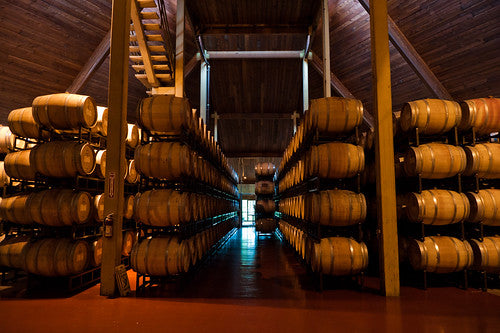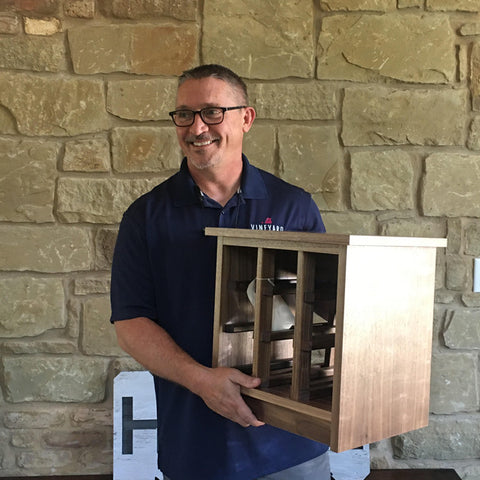
Wine Cellaring: A Beginner's Guide to Successful Wine Aging
New to the world of wine? You must have heard about the different ways to store and age wine properly. Wine cellaring or storing wine under controlled conditions for an extended period protects its quality and enhances its taste. However, it can be overwhelming, especially for those new to the practice.
Our beginner's guide will provide clarity and equip you with the knowledge and tools for successful wine aging by exploring the essential aspects of wine cellaring.
Purpose of Wine Cellaring
What does wine cellaring do to wine? The goal is to enable the wine to undergo slow, controlled changes over time, leading to a more enjoyable drinking experience. Proper cellaring integrates flavors and adds complexity.
-
Enhanced Flavor Profile
Wine cellaring allows the wine to undergo a gradual transformation that can significantly enhance its taste profile. Over time, several things occur:
- Tannins soften: Tannins, naturally occurring compounds found in red wines, contribute to their astringency. Cellaring allows these tannins to polymerize, making them smoother and less noticeable on the palate. This translates to a more pleasant, well-rounded drinking experience.
- Aromas become more complex: As wines age, new aromas emerge, adding depth and complexity to the bouquet. Hints of spice, tobacco, or leather may appear alongside the original fruit notes, creating a more intriguing sensory experience.
- Fruit flavors evolve: Fresh fruit flavors can develop into more nuanced expressions over time. For example, vibrant cherry notes in a young red wine might evolve into a richer, jammier character with proper cellaring.
-
Investment Potential
While the primary aim of cellaring is flavor enhancement, it's worth noting that certain well-preserved and aged wines can gain value over time.
4 Common Types of Wine Cellaring

The approach to cellaring wine can vary depending on your resources and space availability. Here are some common options:
Dedicated Wine Cellar
Ideally suited for serious collectors, a dedicated wine cellar offers a controlled environment specifically designed for long-term storage. These cellars typically feature temperature and humidity controls, insulation, and minimal exposure to UV light. However, creating a dedicated cellar requires significant investment in space and equipment.
Wine Refrigerator/Fridge
A more compact and affordable alternative, a dedicated wine fridge provides controlled temperature and humidity, making it suitable for storing smaller collections or specific wines requiring precise aging conditions.
Cool, Dark Cabinets
If space is limited, a cool, dark cabinet within your home can be an option for short-term cellaring. However, it's crucial to ensure consistent temperature and minimal exposure to light and vibration.
Wine Lockers
Professional wine storage facilities offer individual lockers with controlled temperature and humidity for those lacking dedicated storage space.
The 4 Cs of Wine Cellaring
Creating a successful wine cellar environment revolves around four key factors: Climate, Cleanliness, Control, and Commitment. Understanding and managing these elements will significantly contribute to the quality and enjoyment of your cellared wines.
Climate
- Temperature: Consistent temperature, ideally between 50-60°F (10-15°C), is crucial for optimal wine aging. Fluctuations can hinder natural aging and negatively impact the wine's taste. Consider investing in wine cooling units to maintain consistent temperatures.
- Humidity: To prevent air from entering and spoiling the wine, maintain humidity between 50-70% to avoid drying out the cork. If your cellar environment naturally falls outside this range, humidifiers can help achieve the desired level.
Cleanliness
A clean and odor-free environment prevents the growth of mold or bacteria that can contaminate your wines. Regularly wipe down shelves and avoid storing food or other strong-smelling items in your cellar.
Control
- Light: Excessive exposure to light, particularly direct sunlight, can accelerate aging and lead to a "light strike," causing off-flavors and aromas. Light-protected storage solutions like tempered glass-enclosed wine cellars and cabinets are used to minimize light exposure.
- Vibration: Constant vibrations can disturb the sediment in the wine, affecting its taste and clarity. Minimize vibrations by using vibration-dampening mats under your wine racks or choosing a stable location for your cellar.
Commitment
Wine cellaring is a long-term commitment. Depending on the wine and desired aging timeframe, wine storage time can range from a few years to several decades. Patience and consistency are crucial to ensuring successful aging and reaping the rewards of your cellared collection.
The "4 Cs" provide a foundation for successful cellaring. Implementing these principles will set you on the path to enjoying the unique and rewarding experience of well-aged wines.
Wine Cellaring Process

Here's a breakdown of the critical steps of wine cellaring:
- Choosing the right variety of wine
- Preparing your cellar
- Proper wine storage
1. Choosing the Right Wines
Not all wines benefit from aging. While some wines improve with time, others are meant to be enjoyed young. Wine aging refers to a wine's potential to evolve positively over time. Factors influencing this include:
- Grape variety: Certain grapes, like Cabernet Sauvignon or Nebbiolo, naturally possess higher tannins and acidity, making them better suited for cellaring.
- Vintage: Exceptional vintages with favorable weather conditions often produce wines with better-aging potential.
- Tannins: As mentioned earlier, higher tannin levels contribute to a wine's structure and ability to age gracefully.
- Acidity: Wines with balanced acidity tend to age better, as acidity acts as a natural preservative.
- Quality: Start with well-made wines, as they'll reward your patience.
Wines good for cellaring:
For a beginner, starting with a small selection of the best wines known to age well, like is a good approach. Research the optimal storage conditions for each wine and prioritize proper storage solutions within your budget.
- Some reds like Cabernet Sauvignon, Bordeaux blends, and Syrah
- Some whites (like Chardonnay and Rieslings)
- Dessert wines (like Port).
Wines to Avoid Cellaring:
- Light Whites: Light, fruity whites are best enjoyed young.
- Cheap Bottles: Low-quality wines won’t magically improve.
2. Preparing Your Cellar
Wine Storage Solution
The choice of your cellaring solution depends on factors like space, budget, and desired collection size. Here are common options:
- Dedicated cellar rooms
- Wine refrigerators/fridges
- Cool, dark cabinets
- Wine lockers
Space availability
Space considerations come into play, whichever option you choose. Opt for under-counter wine fridges or understairs wine racks to maximize storage space.
-
Storing Your Wine
- Always store bottles on their side for long-term storage to keep the cork moist and prevent air from entering the wine. (Exceptions: Screw-capped or Vinolok-sealed bottles can stand upright.)
- Maintain a well-organized cellar for easy identification and efficient access to your collection.
Wine Cellaring Additional Considerations
Cellar Management
- Regular monitoring of temperature and humidity is crucial for maintaining optimal cellaring conditions. Consider investing in monitoring tools like thermometers and hygrometers to ensure your wines are stored appropriately.
- Basic cellar maintenance practices
-
- Regularly cleaning shelves and storage units to prevent dust and mold buildup.
- Check corks for signs of drying or damage and replace them if necessary.
- Rotating your collection occasionally to ensure even aging of all your wines.
Enjoying Your Cellared Wines
- Decanting before serving often benefits aged wines. This allows the sediment to settle and separates it from the clear wine, improving its appearance and taste.
- Food pairings for aged wines can be explored based on the specific wine type and flavor profile. For example, aged red wines might complement decadent dishes like braised meats or stews, while aged white wines can pair well with creamy cheeses or seafood.
Takeaway
Following our wine cellaring guide's fundamental principles for beginners (and experts), you can embark on a successful wine aging journey. For all your essential wine cellaring equipment and accessories, browse our website and discover how we can help you build your dream wine cellar, one bottle at a time.
What type of wine do you mainly store, and for how long do you keep it in the cellar?
FAQs: Wine Cellaring

Can you age wine too long?
Yes, you can age wine for too long. While some wines can improve for decades, others may lose their desirable characteristics. Some wines are meant to be enjoyed within a few years of release. Researching the specific wine's aging potential is crucial to avoid over-aging.
Here are some types of wines that are generally meant to be enjoyed within a few years of release and don't necessarily benefit from extended cellaring:
Red Wines
- Beaujolais Nouveau
- Pinot Noir
- Gamay
- Zinfandel
White Wines
- Sauvignon Blanc
- Pinot Grigio/Pinot Gris
- Unoaked Chardonnay
Rosé Wines
Most rosé wines are typically enjoyed for their refreshing acidity and fruit-forward character. They are generally meant to be consumed young, within 1-2 years of bottling.
Sparkling Wines
- Prosecco
- Most non-vintage Champagnes
Does cellaring improve wine?
Cellaring, when done right, can enhance certain wines. It provides a space for flavors to evolve, tannins to soften, and complexity to develop.
How long should I cellar my wine?
It depends on the type of wine. Generally, red wines with robust tannins (like Cabernet Sauvignon) benefit from aging. Start with 3-10 years and adjust based on taste preferences.
Is a wine cellar necessary?
A wine cellar is needed if you have special vintages, growing your collection, and want to preserve your wine's quality and taste.
Is cellaring wine worth it?
Yes. Cellaring wine is an excellent investment to enhance your wine-drinking experience and boost your property's value.
What does ABC mean in wine?
“ABC” stands for “Anything But Chardonnay/Cabernet.” It reflects a preference for exploring lesser-known grape varieties instead of the more mainstream Chardonnay or Cabernet Sauvignon.
Why is it called a wine cellar?
The term "cellar" comes from the Old French celier, the late Latin 'cellarium,' and the Latin 'cella' which means storeroom, storehouse, or chamber. Historically and typically, wine is stored in cool, underground spaces.
Why is wine aged in cellars?
Cellars provide stable and controlled conditions (temperature, humidity, darkness), ideal for aging. Controlled environments allow wines to evolve without abrupt changes.





Leave a comment